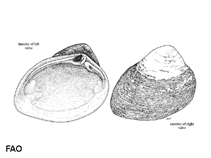Rangia cuneata (Sowerby I, 1831)
Atlantic rangia| Native range | All suitable habitat | Point map | Year 2050 |

|
| This map was computer-generated and has not yet been reviewed. |
| Rangia cuneata AquaMaps Data sources: GBIF OBIS |
Classification / Names Common names | Synonyms | CoL | ITIS | WoRMS
Bivalvia | Venerida | Mactridae
Environment: milieu / climate zone / depth range / distribution range Ecology
Benthic; brackish; depth range 0 - 124 m (Ref. 104339), usually 0 - 2 m (Ref. 104339). Tropical; ? - 15°C (Ref. 104336); 31°N - 17°N, 98°W - 81°W
Distribution Countries | FAO areas | Ecosystems | Occurrences | Introductions
Western Atlantic: The Gulf of Mexico from Campeche to northwest Florida. Introduced to the Atlantic coast of North America (east coast of Florida to Chesapeake Bay and to the Hudson River). Northeast Atlantic: Introduced in Belgium and Poland. Tropical to temperate.
Length at first maturity / Size / Weight / Age
Maturity: Lm ?, range 1 - ? cm Max length : 9.4 cm SHL male/unsexed; (Ref. 104339); max. reported age: 15 years (Ref. 104339)
Short description Morphology
Life cycle and mating behavior Maturity | Reproduction | Spawning | Eggs | Fecundity | Larvae
Main reference
References | Coordinator | Collaborators
Carpenter, K.E. (ed.) 2002 The living marine resources of the Western Central Atlantic. Volume 1: Introduction, molluscs, crustaceans, hagfishes, sharks, batoid fishes, and chimaeras. FAO Species Identification Guide for Fishery Purposes and American Society of Ichthyologists and Herpetologists Special Publication No. 5, Rome. 600p. (Ref. 271)
IUCN Red List Status
(Ref. 130435: Version 2025-1)
CITES status (Ref. 108899)
CMS (Ref. 116361)
Threat to humans
Human uses
Fisheries: commercial
| FishSource | Sea Around Us
Tools
More information
Max. ages / sizes
Length-weight rel.
Length-length rel.
Length-frequencies
Mass conversion
Abundance
Internet sources
BHL | BOLD Systems | CISTI | DiscoverLife | FAO(Publication : search) | Fishipedia | GenBank (genome, nucleotide) | GloBI | 1 GoMexSI (interaction data) | Google Books | Google Scholar | Google | PubMed | Tree of Life | Wikipedia (Go, Search) | Zoological Record



